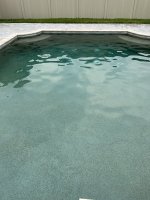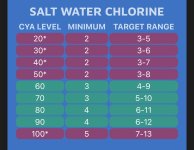- Jan 24, 2021
- 159
- Pool Size
- 19910
- Surface
- Plaster
- Chlorine
- Salt Water Generator
- SWG Type
- Jandy Truclear / Ei
It’s that time of year again, where we are opening up our pools and trying to get everything right. Or in my case, living in Florida, trying to make seasonal adjustments as I never close my pool.
I have had this pool for three years and this is the second year in a row that I have had mustard algae. The first year there was no issue. Last year, I had a hard time determining if it was pollen or mustard algae for a while but eventually determined that since it was more in the corners of the pool and shaded areas it was most likely MA. I followed the SLAM protocol followed by the MA FC shock using liquid bleach. Followed up with regular brushing and vacuuming and the problem went away. Had no issues for the rest of the season or all winter. I attributed the MA to me not keeping on top of seasonal SWG chlorine level percentage adjustments and it getting down to a FC level of 2 or maybe less, IIRC. So this year, I made sure to bump up the chlorine percentage early and it seemed to be maintaining at 5.5 and 60-70 for CYA. But the yellow returned. It’s been an extremely high pollen year and the chlorine level seemed to be maintaining so until I brushed today and noticed my chlorine level had dropped to 3.5 I thought it was pollen.
My question is this: How long can MA stay in hidden places to come back and haunt you? Long enough to not show up for almost a year and then come back? I’m asking because I did not scour every book and cranny, although I did get most areas with a small brush. I’m already starting the SLAM process but I’m very curious why I would get MA two years in a row at about the same time of year. In three years of using the TFP method these two instances are the only times I’ve ever had issues.
Today’s testing results were as follows:
PH: 8.3
Chlorine: 3.5
CYA: 60
TA: 120 (this has been rising over the last few tests from 90-100-120 despite adding acid)
CH-not tested as the bottle exploded but has been maintaining at 350.
Prior test about 9 days ago, was:
PH: 8.1
Chlorine: 5.5
CYA: 60
TA: 100
CH: 350
Salt: 3600
Side note, I do always seem to be chasing PH and TA down.
I have had this pool for three years and this is the second year in a row that I have had mustard algae. The first year there was no issue. Last year, I had a hard time determining if it was pollen or mustard algae for a while but eventually determined that since it was more in the corners of the pool and shaded areas it was most likely MA. I followed the SLAM protocol followed by the MA FC shock using liquid bleach. Followed up with regular brushing and vacuuming and the problem went away. Had no issues for the rest of the season or all winter. I attributed the MA to me not keeping on top of seasonal SWG chlorine level percentage adjustments and it getting down to a FC level of 2 or maybe less, IIRC. So this year, I made sure to bump up the chlorine percentage early and it seemed to be maintaining at 5.5 and 60-70 for CYA. But the yellow returned. It’s been an extremely high pollen year and the chlorine level seemed to be maintaining so until I brushed today and noticed my chlorine level had dropped to 3.5 I thought it was pollen.
My question is this: How long can MA stay in hidden places to come back and haunt you? Long enough to not show up for almost a year and then come back? I’m asking because I did not scour every book and cranny, although I did get most areas with a small brush. I’m already starting the SLAM process but I’m very curious why I would get MA two years in a row at about the same time of year. In three years of using the TFP method these two instances are the only times I’ve ever had issues.
Today’s testing results were as follows:
PH: 8.3
Chlorine: 3.5
CYA: 60
TA: 120 (this has been rising over the last few tests from 90-100-120 despite adding acid)
CH-not tested as the bottle exploded but has been maintaining at 350.
Prior test about 9 days ago, was:
PH: 8.1
Chlorine: 5.5
CYA: 60
TA: 100
CH: 350
Salt: 3600
Side note, I do always seem to be chasing PH and TA down.





